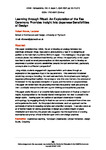Learning through Ritual
| dc.contributor.author | Brown, Robert | |
| dc.date.accessioned | 2022-08-04T16:56:27Z | |
| dc.date.available | 2022-08-04T16:56:27Z | |
| dc.date.issued | 2007-04 | |
| dc.identifier.uri | http://hdl.handle.net/10026.1/19501 | |
| dc.description.abstract |
This paper considers how mitate, the act of drawing an analogy between two seemingly unrelated things, was used to give students a ‘way in’ to designing an addition to the main hall of a Shinto Shrine in Japan. The challenge of the project was to create places that celebrate local identity; yet without the opportunity to visit Japan, how then to avoid external preconceptions or misinterpretations, and to develop an awareness of another culture’s sensibilities towards the built environment, particularly concepts alien to a Western perspective? Using mitate, students engaged with Japanese beliefs and values through an exploration of the Japanese ritual of the tea ceremony. This ceremony introduced certain key concepts, including: the wabi-sabi aesthetic; the emphasis upon feeling in Japanese philosophical tradition; the concept of one-time one-moment; the construct of ‘in-between’ in the Japanese conception of space; and the notion of purposefulness. This paper will review how this grounding informed the students’ work and prompted them to critically re-examine their own a priori thinking and established practices. This paper posits the use of an experientially-based exploration of ritual as a means of inquiry, in juxtaposition to the visually-biased investigations that tend to prevail in the design studio. Drawing upon the tradition of participant observation in social anthropology, by engaging directly in ritual we can come to understand how others see and experience the world. As this project demonstrates, such an approach can be particularly effective in revealing complex and unfamiliar concepts. It can also serve as an effective means for raising awareness of design as a holistic inquiry of place, inhabitation and tectonics; the project also suggests that the experience of crossing boundaries can prompt critical reflection upon one’s own design practices. | |
| dc.format.medium | Web-based journal | |
| dc.language | English | |
| dc.language.iso | English | |
| dc.publisher | Centre for Education in the Built Environment | |
| dc.title | Learning through Ritual | |
| dc.type | journal-article | |
| dc.type | Article | |
| plymouth.issue | 1 | |
| plymouth.volume | 4 | |
| plymouth.journal | Transactions | |
| plymouth.organisational-group | /Plymouth | |
| plymouth.organisational-group | /Plymouth/Faculty of Arts, Humanities and Business | |
| plymouth.organisational-group | /Plymouth/Faculty of Arts, Humanities and Business/School of Art, Design and Architecture | |
| plymouth.organisational-group | /Plymouth/REF 2021 Researchers by UoA | |
| plymouth.organisational-group | /Plymouth/REF 2021 Researchers by UoA/UoA13 Architecture, Built Environment and Planning | |
| plymouth.organisational-group | /Plymouth/Users by role | |
| plymouth.organisational-group | /Plymouth/Users by role/Academics | |
| dc.publisher.place | United Kingdom | |
| dc.rights.embargoperiod | Not known | |
| rioxxterms.licenseref.uri | http://www.rioxx.net/licenses/all-rights-reserved | |
| rioxxterms.type | Journal Article/Review |


